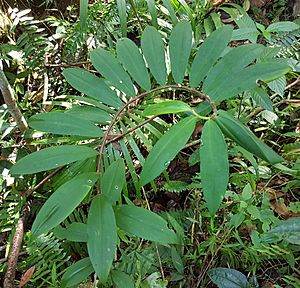Crepe ginger facts for kids
Quick facts for kids Crêpe ginger |
|
|---|---|
 |
|
| Cheilocostus speciosus from Tortuguero, Costa Rica | |
 |
|
| Wild Cheilocostus speciosus from Bukidnon, Philippines | |
| Scientific classification | |
| Genus: |
Cheilocostus
|
| Species: |
speciosus
|
The Crêpe Ginger (scientific name: Cheilocostus speciosus) is a cool flowering plant. It belongs to a plant family called Costaceae. Some plant experts also call it Hellenia speciosa.
This plant originally comes from southeast Asia and nearby areas. You can find it from India all the way to China and Queensland, Australia. It's super common on the Greater Sunda Islands in Indonesia. People have also introduced it to places like Mauritius, Réunion, Fiji, Hawaii, Costa Rica, Belize, Melanesia, Micronesia, and the West Indies. Many people grow it because it looks beautiful.
Contents
What is Crêpe Ginger Like?
Crêpe ginger plants are special. They are different from regular gingers. They have their leaves arranged in a spiral, not in straight rows.
This plant can grow new plants from its underground stems, called rhizomes. Birds also help spread its seeds. They eat the fruits and then carry the seeds to new places.
People in South Asia and Southeast Asia grow crêpe ginger for its traditional uses. It is also grown all over the world just for its beauty. In some places, it has grown so much that it has become an invasive species. This means it can take over areas where it doesn't naturally belong.
Where Does Crêpe Ginger Live?
You can often find crêpe ginger growing in wet places. It likes roadside ditches and low areas in tropical forests. These plants usually start to flower when the rainy season begins.
How People Use Crêpe Ginger
Crêpe ginger has been used for a long time in traditional medicine. In Ayurveda, which is an ancient Indian healing system, the rhizome (underground stem) was used. People used it to help with fevers, rashes, and breathing problems like asthma. It was also used for some stomach issues.
In Mizo Traditional Medicine, it helps with kidney and other urinary problems. In the past, Malay people used it in their traditional beliefs. They also used it for high fevers, smallpox, and as a way to clean out the body.
The crêpe ginger has many different names around the world. Here are just a few:
- isebsab in Palauan
- keu, kemuk or keumul in Bengali
- keukand in Hindi
- thebu in Sinhala
- pakarmula in Gujarati
- pushkarmula in Marathi and Sanskrit
- jom lakhuti in Assamese
- kostam in Tamil
- Kosta in Kannada
- Kostamu in Telugu
- Okchak Khombi in Manipur
- sumbul in Mizo
- setawar in Malay
Images for kids
-
Bract of Crêpe Ginger after seeds are taken out
-
Inflorescence of Crêpe Ginger after the flowers have died
-
Cheilocostus speciosus in Basse Terre, Guadeloupe
-
Cheilocostus speciosus in Hawaii
-
Rhizome (underground stem) of Crêpe Ginger
















